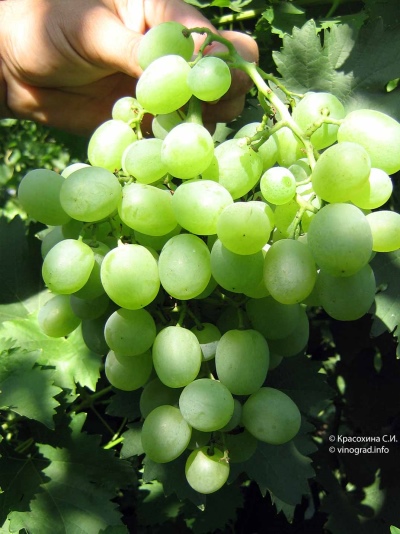
- Authors: Ya.I. Potapenko
- Appointment: dining room
- Berry color: White
- Taste: harmonious
- Ripening period: very early
- Ripening period, days: 105-110
- Frost resistance, ° C: -25
- Name synonyms: Song, OV-6-pc
- Bunch weight, g: 600-900
- Tasting assessment, points: 7,9
Grapes are an unpretentious plant that can grow in any part of Russia. Therefore, this culture is so loved by many gardeners. The White Miracle grape is ideal for many regions of the country. In this article, we will consider the features of grapes, their distinctive features, frost resistance, as well as shelf life.
Breeding history
The variety was bred in Russia by crossing two species: Delight and Original. For the breeder Ya. I. Potapenko, it was important to create a hybrid that would grow well in central Russia, be frost-resistant and at the same time very attractive in appearance. And he did it.
In addition to its main name White Miracle, this variety can also be called:
Song;
Monomakh's hat;
OV-6-pc.
Description
The hybrid belongs to the early maturing varieties. The bushes are medium-sized, the vines are of a maroon hue. The leaves are small, bright green. In the spring, a large number of fruitful buds are formed, because of this, it is necessary to remove extra eyes annually. Due to the large number of stems, yields may suffer.
A number of positive qualities can be noted:
early ripening;
long shelf life;
a bountiful harvest;
large clusters and berries;
unpretentiousness in growing;
high frost resistance;
resistance to many diseases;
application both in home life and in winemaking.
Ripening period
As mentioned above, the culture is early maturing, on average it ripens 105-110 days. The harvest falls in mid-August.
Bunches
The bunches are conical in shape, the density of the berries is average. By weight, the bunches go out to 0.6-0.9 kg. With good fertilization and care, the yield can increase up to 1.5 kg.
Berries
The fruits are large, oval or round in shape. Length 24 mm and width 20 mm. By weight on average 6-8 g. The skin is thin, with a slight gloss. The shade is closer to green, but if the berries were in the sun, then there is an admixture of yellow. The pulp is firm and juicy.
Taste
In terms of taste, these grapes are sweet, slightly sugary, the sugar level is almost 20%, and the acidity is only 6-7 g / dm3.
Yield
Average yield. Up to 25 kg of berries are harvested from one bush.


Growing features
It is best to plant seedlings in the spring in the southern regions, in the middle lane it is best in June. Otherwise, there is a risk of freezing new shoots. For the soil, it is worth choosing land rich in black soil, loam or sandy loam.
The formation of the bush takes place over 4 years.
Landing
It is worth choosing a place where water does not accumulate.
In order to plant seedlings, it is necessary to dig holes of 0.8 m in diameter and the same in depth, the distance between the pits is 1.5 m.And between the rows there should be 2 m each.A humus is placed at the bottom, then a layer of soft earth is sprinkled which is rich in minerals. We immerse the seedling, bury it, tamping the ground. Water abundantly.Then you can mulch the soil. Within a week, it is necessary to tie up the bushes and make trellises for them.

Pollination
This hybrid has flowers of both sexes, so additional pollination is not required. On the contrary, this species is suitable for pollination of other grape varieties. Therefore, it is often planted near other vineyards.
Pruning
The first pruning of shoots occurs immediately after winter, branches that have broken or have not survived the winter are removed. Then diseased vines are removed. And also pruning occurs after harvest to remove some of the weight from the stem.
In the early years, the pruning of young seedlings is very carefully monitored. Young shoots are very fragile. In the first year, 2-3 kidneys are removed. With proper care in the second year, 6-7 shoots are formed at the stem, of which only 3-4 strong shoots are left, 4 eyes are removed. In the third year, the first fruiting begins.



Frost resistance and the need for shelter
Grapes White miracle tolerates frosts down to -25 degrees. But many growers will cover the stems anyway to keep the fruit in good shape.

Diseases and pests
High resistance to a number of fungal diseases, the variety is not susceptible to diseases such as mildew, gray rot or powdery mildew. But for preventive purposes, it is still worth spraying the grapes twice a season with special preparations for fungal diseases.
The main pests in this hybrid are wasps and bees, which are not averse to feasting on them during the ripening period. Therefore, in advance it is worth taking care of special traps for insects, or making mesh bags.

If a grape is exposed to any disease or insect, this always affects its appearance.
Storage
You can store the harvested crop in a specially prepared place, suspended or in boxes.
For a suspended view, it is necessary to tie two brushes, but so that they do not touch each other. You can separate them a little with a stick, from which the brush is hung. You can store it in the attic or on the veranda.
It is best to put paper in the containers on the bottom, then a small layer of sawdust, put the brushes not close to each other in one layer, then lay again with sawdust and put a second layer.
In both cases, the grapes are stored for up to 2 months.











































































